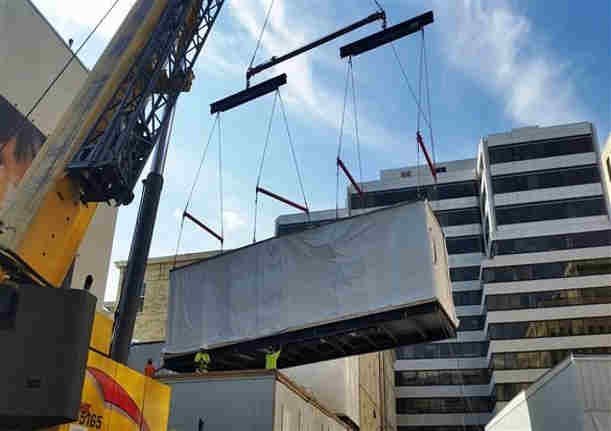New Modular Uses for Old Buildings
Modular buildings promote sustainability and offer a number of environment-saving benefits. One ingenious “green” use of modular buildings in the Philadelphia area is the gigantic new 180,000-square-foot data center that is under construction inside a historic building in Bucks County, one hour north of the city by car.
The building is the former U.S. Steel Fairless Works Motor Building which was built in 1953 to house the electric motors that ran the steel mill. In a few months, it will see new life as the home of the Keystone NAP (Network Access Point) which will accept servers, storage and switches to help businesses take advantage of the latest technologies.

Instead of demolishing the historic building or using shipping containers to configure the space, the company chose to renovate the building and construct modular units to fit within the three 60-foot by 1000-foot floors and become fully self-contained, stackable private datacenters for customers.
The modular units, nicknamed KeyBlocks, are available in a double-wide size that holds 22 server racks and a quadruple-wide size that holds 44 racks. They are custom built off-site in a factory-controlled environment and then moved into position in the building. Each KeyBlock module will have its own power conditioning, fire suppression, cooling and security system.
Another benefit is that the modules can be easily replaced as customers’ needs or technologies change, without disruption of the data center environment. When full, the building is expected to accommodate over 240,000 servers.
Ironically, modular construction is not new to Fairless Hills. The town was developed using prefabricated modular homes (made by a subsidiary of U.S. Steel) to house the Fairless Works plant’s employees beginning in 1952.
Thanks to the mill’s proximity to power generating facilities, customers of the new data center will benefit from relatively inexpensive power due to low transmission fees. The four nearby industrial-grade power stations generate a combined 2,000 megawatts of electricity from diversified coal and gas, natural gas, landfill gas and trash-to-steam sources.
The facility is located within driving distance of all the major data center markets in the Northeastern U.S., and will have room to house hundreds of people in the event of another physical disaster like Hurricane Sandy.
Smarter Building Strategies
American buildings are hard on the environment. According to the EPA, they are responsible for 68% of our total electricity consumption, 38% of CO2 emissions, and 12% of total water consumption. By 2025, they will be the largest emitters of greenhouse gases on the planet.
However, state-of-the-art manufacturing technologies, mechanized quality control and 3D and 4D design capabilities have made modular construction suitable for a wide range of residential, commercial and industrial uses. A visit to the website of a modular building company like Modular Genius will demonstrate how much progress has been made in the industry.
Some of the environmental benefits of modular buildings include their use of recycled steel and sustainably sourced timber, improved indoor air quality controls, better sealing to reduce heating and cooling costs, better use of natural light through glass walls and open designs, and minimal waste on the front end with greater accountability of materials and more accurate factory measurements.
As energy and materials costs rise, consider the economic advantages of using modular buildings in Philadelphia to replace, revitalize, and/or re-purpose old historic structures. Configure custom-designed modules to suit just about any imaginable type of application and reap their “green” benefits.
